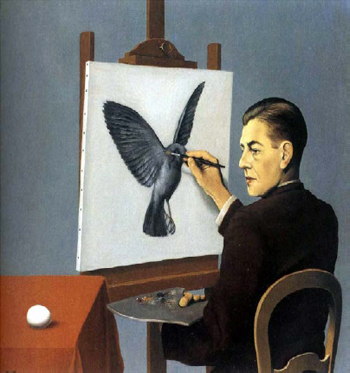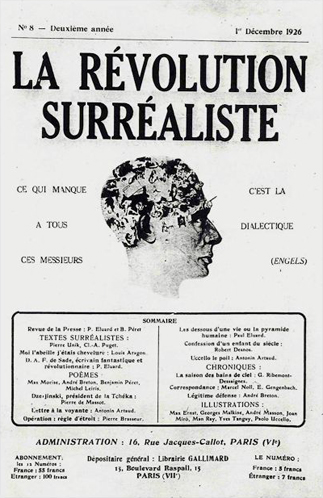Tube paints provide the freedom to paint out-of-doors, formerly, painters mixed pigment in their studios. This newfound ability is revolutionary to the world of painting; it is the catalyst announcing the new age of Modern Art, and the passing of the Renaissance era. Beginning with Monet, successive paintings illustrate the emergence of fresh styles and techniques. The London based, Winsor & Newton Company invented and manufacture tube paints. This image is of their first tube paints, 1840 - 1911.
René Magritte (1898 – 1967) suffers the loss of his mother when she commits suicide in the Sambre River. This is the same river he paints in one of his first works at The Royal Academy, in Brussels.
By the age of twenty-four, René marries his childhood sweetheart Georgette - but not before accepting a job to design wall paper. A couple of years pass, and he shifts to freelance graphic design for a number of clients, including the Alfa Romeo car manufacturer. This is a cute candid shot of the couple.
The pair move to a suburb of Paris in the late ‘20s. The trip is fueled by their desire to meet the small “Surrealist Group” attracted to the new philosophies of socialism and communism, as they relate to the arts. The group is led by, the writer, André Breton. René makes two contributions to the short-lived journal.
With Germany’s invasion of Belgium in 1940, René and Georgette flee temporarily to the South of France. Magritte’s early work receives international acclaim. The 1950s bring relief and happier times. The Clearing, 1944, reveals a new light-heartedness. Regrettably, this rare talent succumbs to pancreatic cancer.

Modern, Surrealist movement (1924 – 1930s) Surrealism finds its roots in feelings of aversion to the atrocities of the First World War between 1914 – 18. In 1917, French poet, Apollinaire uses the term, “Surréaliste” to describe a form of expression that surpasses realism, and the movement’s name is established.
Surrealists in Belgium and their counterparts from elsewhere differ in point of view and painting style. Several paintings in the video, René Magritte: The Beauty of Surrealism are graphic.
A controversial shift throughout Europe happens when an international style described as Art Deco, begins in Paris in 1925. Its influence crosses the big pond where architecture in New York City becomes refreshingly different. Modern jazz, zigzag patterns, sleek fashions, and unusual furniture catch on like wild-fire.
A better exchange rate between dollars and francs leaves Greenwich Village in the dust and Paris becomes the new destination. This occurs before the stock market crash, and the Great Depression.

Go on to Describe, Analyze, Interpret & Conclude. Contact me for help.
The Treachery of Images (This is not a pipe.) 1929. Oil on canvas. 24 x 32 in. (60 x 81 cm.) is one of a series of word-image paintings by Magritte suggesting the style of illustrated children’s books, and his early career in advertising. The artist lays out his rationale in “Words and Images” written in the same year.
How could an image of a pipe actually be a pipe? That is Magritte’s point: “The famous pipe. How people reproached me for it. And yet, could you stuff my pipe? No, it’s just a representation is it not? So, if I had written on my picture “This is a pipe” - I’d have been lying.”
In 1936, art dealer, Julien Levy presents the first one-man exhibit of Magritte’s work in New York City, and the pipe becomes a hot topic of conversation.
Decades later, Magritte makes the same point in Force of Habit,1960. The artist continues to find subject matter to express the rest of his life. Fans of all ages delight in his weird paintings and odd sense of humor. Andy Warhol, in the Postmodern Collection, cites Magritte as a profound influence.